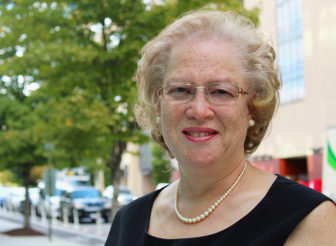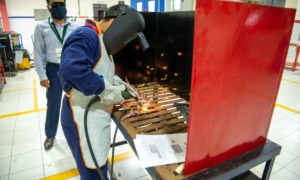
Monkey Business Images/Shutterstock
.
“We have to work together for the success of our students,” said William Lee, assistant principal at Suitland High School, at an event a few months ago. It was celebrating collaboration between staff and the nonprofit partners that work inside the school to offer services to youth through the Ready for Work initiative.
Ready for Work is a place-based initiative in Prince George’s County, Md., that was developed to help young people successfully transition to adulthood with the academic, technical and life skills they need to be career- and college-ready. The effort is a partnership between Venture Philanthropy Partners (VPP) and Prince George’s County Administration, Prince George’s County Public Schools, local business leaders, philanthropy and several nonprofit organizations. The initiative operates at the school district level and within three high schools in the county — Suitland, Oxon Hill and High Point.

Carol Thompson Cole
One component of the initiative at Suitland High School is youthCONNECT, a network of high-performing nonprofits that collaborate with schools to help students graduate on time and improve their readiness for employment and post-secondary education. The youthCONNECT model is distinct from many other youth-serving programs because instead of operating as an out-of-school time (OST) program, it operates during the day.
Embedding youthCONNECT into the school and working during school hours was requested by school leaders. It is particularly beneficial at the high school level because the support services don’t compete with sports, clubs, work or other after-school activities, mitigating some barriers for students to access youth services. It also fosters strong collaboration between nonprofits and schools and allows providers to address issues in real time. During the 2018-19 school year, youthCONNECT served 1,475 students at Suitland High School.
Between classes, band or orchestra, sports and other extracurriculars, jobs and a host of other out-of-school activities, nonprofits that serve high schools are already competing with many other interests. Providing support inside schools means that students don’t have to go anywhere to access the help they need, significantly reducing time and transportation barriers they may have to accessing support from the nonprofit organizations.
The same place, any time
In partnership with the school, the five youthCONNECT nonprofit partners have a dedicated space inside the school. Students can drop in during the day and have one-on-one conversations with their advisors about their academics, goals, career plans, etc. This room is seen as a safe space where students know they will find caring adults who will listen to them and are focused on helping them succeed in high school and beyond.
By operating inside a school, youth-serving nonprofits and school staff can communicate directly about student needs. This means that a teacher who identifies a struggling student can easily and quickly refer that student to a nonprofit partner. The youthCONNECT network at Suitland includes Hillside Work-Scholarship Connection, Maryland Multicultural Youth Center, Year Up National Capital Region, PeerForward and Urban Alliance.
To help the nonprofit partners, school staff and school leaders work seamlessly together. A VPP staff member is based in the school full time as the Ready for Work in-school director. Teachers often approach that director to discuss a student with particular challenges in order to identify the most appropriate nonprofit partner and connect those students to the services to support them. The in-school model also broadens the view of school staff about the possibilities for some students who have the greatest challenges. By getting to know the organizations and their program offerings, teachers and other staff have a clearer sense of the resources that can help their students realize their full potential.
As a network, the youthCONNECT nonprofit organizations are also better able to communicate with each other — sharing insights and learnings and brainstorming ways to better serve students. Since these organizations provide complementary services, they are also able to refer students to each other. For example, a student who is receiving academic assistance from one nonprofit partner might express interest in entering a professional training program after high school. Being part of the youthCONNECT network means that that organization can connect the student to another nonprofit partner that can support them.
Even more importantly, a presence inside the school allows youth-serving organizations to become embedded in school life and culture — gaining a deeper understanding of school policies and issues that relate to their work and adapting their own approach when appropriate. When the school system instituted a new attendance policy, the in-school director met with school leaders to fully understand the new rules and then facilitated a discussion with all the nonprofit partners to learn about the changes and how they affected the students they serve. Because they were inside the school, these nonprofits received the information within days of the new policy being released and were able to have conversations with students and parents to help keep their attendance rates up.
Stronger ties between the adults
Nonprofit partners with an intensive case management model routinely visit classrooms during the day to make sure their participants are in class and check in with teachers — the kind of immediate action and accountability that just would not be feasible if they were not onsite.
All these benefits are predicated on the fact that working onsite during the school day and the presence of the in-school director helps to create strong, authentic relationships between the schools and youth-serving nonprofits. Working together each day, they are given the opportunity to know and learn to trust each other. If an issue arises, a nonprofit representative can just walk upstairs to speak directly with a teacher. Building personal connections means that teachers and school staff are also more willing to reach out to the nonprofits and see them as a resource.
Teachers and school staff are much more likely to connect students to these nonprofit partners and give the partners space to work together with each student’s unique needs, whether that’s academic enrichment, developing job skills, applying to college or receiving personal mentorship. And, school staff recognize the value in having people they trust to help carry the load of supporting their students.
“We’re not alone. We have a network of partners in the building. It’s not just me in the classroom, and students get support throughout their whole high school career,” said Suitland guidance counselor Richelle King.
At the end of the day, it’s the students we are focused on when we consider the value of an in-school youth services model.
When philanthropy, schools and government work together to bring nonprofit services into schools, they create an environment where youth services are more accessible to students and build strong long-lasting relationships that help young people pursue and achieve their goals.
Carol Thompson Cole is president and CEO of Venture Philanthropy Partners, a philanthropic investment organization that builds strong nonprofits and strategic networks that measurably improve the lives of children and youth throughout Greater Washington.





























